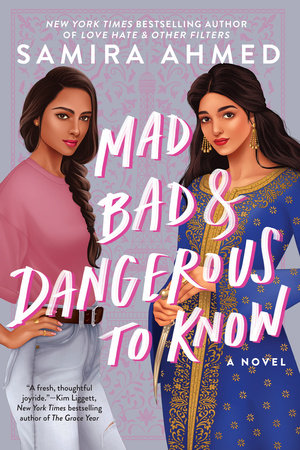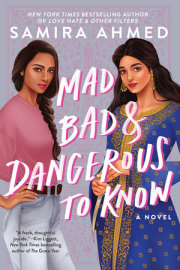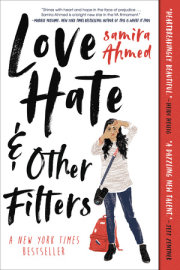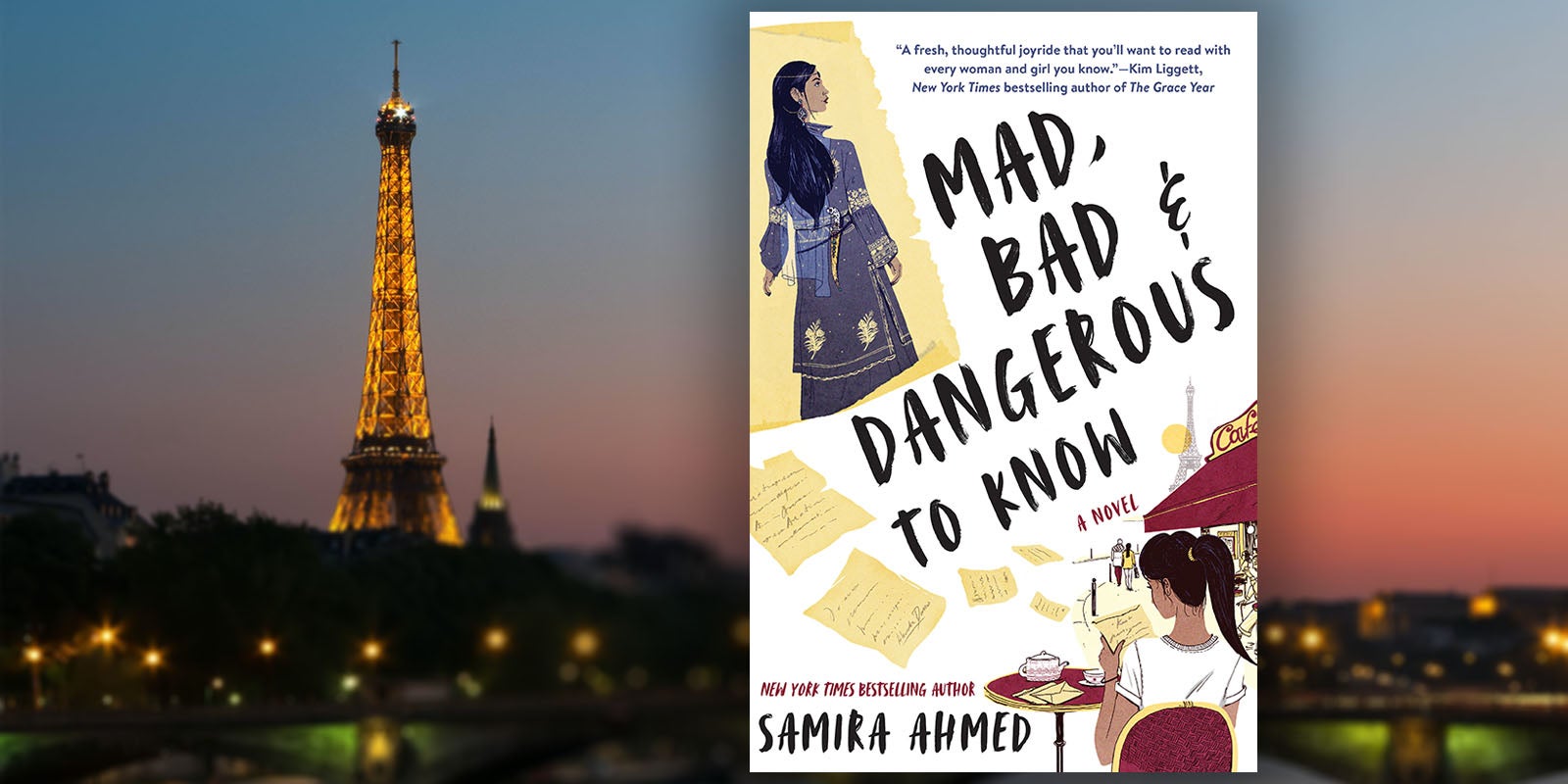Khayyam I live in between spaces.
The borders between nations, the invisible hyphen between words, the wide chasm between “one of us” and me alone.
French American.
Indian American.
Muslim American.
Biracial. Interfaith. Child of immigrants.
A Parisienne for one month a year: the month when all the other Parisians flee the city.
A girl staring at her phone screen, looking for love but knowing it’s not going to show up.
I didn’t choose any of this. Which is not to say I wouldn’t have, given the opportunity. But it’s not like I ever had the option.
I don’t even get a say in my diminutives. It’s always “Frenchie” or “la petite Américaine.”
The people who can’t guess what I am think I’m “exotic.” Some people say I’m lucky to be an ethnomorph—a person whose brown skin, brown hair, and brown eyes make it seem like I could be from half the countries in the world. But I’m not a passport that everyone gets to stamp with a label of their choosing. Others look at me and try to shove me into their own narrative to define who and what I am. But I’m not a blank page that everyone else gets to write on.
I have my own voice.
I have my own story.
I have my own name. It’s Khayyam.
Khayyam I just stepped in dog shit. Bienvenue à Paris.
Welcome to my life of constant code-switching. Witness my attempts to blend an occasional impulse for Bollywood melodramatics with my flair for complaining like a local. I shouldn’t be cranky, summering in Paris. I should be an expert at dodging excrement on sidewalks and accustomed to tepid service from waiters and sardonic smiles at my fluent but slightly accented French. And I should absolutely be prepared for les grèves—the strikes that bring the Métro to a standstill every single time we’re here.
I should be French about it and nonchalant.
Instead, I’m American and have no chill.
Because it
is hot. The air-conditioning is mostly aspirational. And I’m a captive here, since my parents value family vacation tradition more than my desire to stay in Chicago, stewing in self-doubt and woe-is-me pity and the truth universally acknowledged that the forces of entropy attack you on all fronts.
This is what metaphorical multiple organ failure feels like:
My head: I have likely, most probably, almost definitely royally screwed up my chances of getting into the School of the Art Institute of Chicago—my dream college that I’ve been shooting for since ninth grade. It is
the school if you want to go into art history. Which I do. Obsessively.
My heart: Belongs to Zaid.
Still. Zaid, my not-exactly boyfriend, but only because he never actually called himself my boyfriend, who is thousands of miles away in Chicago.
My lungs: On top of the dog crap, there’s a railway strike today, somehow precisely coinciding with this heat wave and my arrival in Paris. The air is humid and so thick I’m panting.
But those are merely symptoms.
The underlying cause? An essay. Yeah, really.
The School of the Art Institute is super competitive, so I wanted to find a way to stand out from the pack. I had this brilliant idea to submit an absolutely mind-blowing essay for its Young Scholar Prize. Technically, I was ineligible because you have to be a high school grad to enter. I was only a junior,
and I petitioned the judges to make an exception. I didn’t want a technicality standing in the way of my dreams. Besides, my college counselor told me it would show I have “moxie” and would look great on my college applications. I was certain I had solved a centuries-old art world mystery, proving that Eugène Delacroix had secretly given a painting—one of several—from his
Giaour series to the writer Alexandre Dumas, the
all for one, one for all dude. Not just any painting in the series—
the exact one on display at the Art Institute. I was going to astound the old fogey museum curators with my genius. I would unveil a secret that was hiding in plain sight. I would be the youngest prizewinner ever, an art world darling. I based my entire theory on a single sentence in a twenty-year-old article about Delacroix I found online and followed down a rabbit hole. Apparently fake news is also old news.
The thing with confidence, though, is that when you’re proven wrong—and holy hell, was I proven wrong—you wither away into the smallest version of yourself. And head judge—now my lifelong nemesis—Celenia Mondego made sure of that. In her words, I had written,
“an earnest if ill-conceived attempt at unraveling a mystery of provenance that fell far short of its ambitions due to slipshod research—a catastrophic inability to grasp obvious facts. The work of a dilettante, not a future art historian.” The words still stab.
Maybe I could deal with it better if I didn’t feel so alone, but
my person,
my I’ll-always-be-there-for-you pseudo boyfriend, graduated from Lab High in June and is apparently so busy getting ready to leave for college that he can’t even pick up the phone—his second favorite appendage. Meanwhile, I’m pleading with myself not to text him
again. Clinging like a lifeline to the one text he did send while I was mid-flight:
I’ll see you when I see you. p.s. I got Ice Capades. Quoting
our thing,
our ridiculous thing, an inside joke from our cheesy retro first date movie. I melted. Ugh.
I keep letting myself forget that it’s at least partly his fault I screwed up my prize essay. Somewhat. Probably. Indirectly. It seemed like every time I was in the library researching or trying to write, he’d sneak up behind me in the stacks and kiss me on the neck. His kisses are highly distracting.
Basically, I’m seventeen and already washed up. What do I do now?
Mom would tell me to go easier on myself and to trust my own voice to find a way out.
Papa would remind me that I’m young and in Paris, a city with pastries on every corner, and that life is still beautiful: C’est la belle vie, chérie.
Zaid, if he were acknowledging my existence and wasn’t part of my problem, would probably tell me to forget about everything and suggest creative ways in which he might be able to help me with that.
And Julie, my best friend, who is currently inaccessible because she’s on a Dark-Ages, technology-free family holiday at a cabin in Door County, would tell me to figure out where I want to go and do whatever it takes to get there. Easy for her to say—she’s both an unstoppable force and an immovable object.
Here’s the thing: I actually know where I want to go. But too many things I can’t control keep getting in my way.
Sometimes literally.
With les grèves there’s no Métro, and every electric scooter and bike share is taken. Normally I wouldn’t mind a long, leisurely walk along the quais of the Seine River on the way to the Petit Palais—that’s kind of the point of being in Paris. But I’m reminded that this is why there are no songs about August in Paris, when it’s all tourists and la vie en sweat instead of the Hollywood version of Paris where it’s perpetual spring, when young love and chestnut trees are always in bloom.
If I believed in fate, I’d say the universe was conspiring against me.
The courtyard café of the Petit Palais has always been my reliable refuge. I plan on photographing every inch of its meandering path, fragrant plants, blue-and-gold tiled fountains, and, of course, the perfectly pillowy macarons I’ll be inhaling at a small wrought-iron table amongst the blossoms. Luckily, the place is made for Instagram, which is good because I need new content to replace all the dusty old books and archival material I posted in my “ill-conceived” attempt to impress the ultimate
we are not amused, judgiest of judges Celenia Mondego.
Maybe meticulously cataloguing my trip will help me forget my “catastrophic inability” to do anything right.
And maybe, perhaps, Zaid will see my posts and remember I exist.
First, though, I need to scrape the remaining dog crap from my red All-Stars.
I skulk into the shadows of the sculptures of naked women flanking the alabaster staircase that leads to the doors of the Petit Palais. As soon as I bend down to inspect my left sole, I hear someone behind me attempting to stifle a laugh.
Do not look, Khayyam. Keep your head down. “Welcome to Paris!” a honeyed French accent declares in English.
I roll my eyes. I almost decide to bite back in French, but this arrogant jerk already chose my preferred language for sparring. “How do you know I’m not from Paris?” I ask with my back still turned to him.
“I’m s-sorry,” the Frenchman stammers.
I stand and whirl around, ready to go for the jugular, but see that this particular jugular leads to an extremely cute face.
Copyright © 2020 by Samira Ahmed. All rights reserved. No part of this excerpt may be reproduced or reprinted without permission in writing from the publisher.




